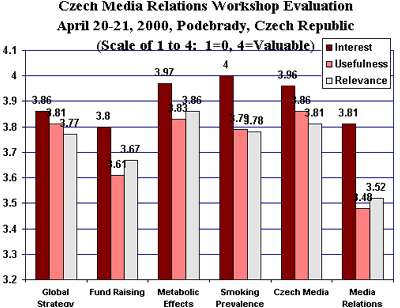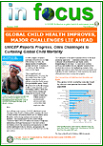|
Media Outreach to Promote Tobacco-Control in the Czech Republic
On 19 April 2000 tobacco control advocates from both sides of the Atlantic descended upon Podebrady, a resort town on the outskirts of Prague. Their mission—developing practical strategies for accessing the Czech news media and circulating stories on tobacco control as part of a two-day Media Relations Workshop -- the second of three planned for Czech health professionals from government hygiene stations, nongovernmental organizations (NGOs) and public health groups. A total of 42 District Hygiene Station (DITs) officers and NGO health professionals participated, an indication that more DITs and others have joined the network in the past six months. Dr. Alyssa Easton, an epidemiologist from the US Centers of Disease Control and Prevention, Atlanta, summarized the global tobacco epidemic and worldwide strategy for tobacco control. She provided global trends for tobacco-related deaths, especially in Central and Eastern Europe and the Czech Republic. She also described regional surveillance, country profile projects, global youth tobacco surveys, legislative analyses and other youth oriented projects--all strategies derived from the World Health Organization and CDC’s collaborative efforts. Dr. Rudolf Poledne discussed the direct metabolic effects of smoking in atherosclerosis. His data on triglyceride levels indicated that they are leveling off in Czech men while they continue to increase in women. Cholesterol levels dropped drastically in 1992 after the Czech government cancelled subsidies for food products including butter and meat. Hana Sovinova, M.D., of the National Institute of Public Health and one of the leading Czech experts on smoking cessation and tobacco control explained that early smoking among Czech teens was correlated with higher incidences of drug use, alcohol abuse and problems with learning. She linked the onset of teen smoking to tobacco advertising and the fact that alcohol use and smoking among children is not sufficiently regulated in the country. This led to a general agreement that the participants would draft a statement to the Czech Parliament weighing in the participants’ opinion about a pending bill in the Czech legislature. This bill proposed regulating smoking, alcohol and drugs. The group proposed that smoking prevention and cessation should have its own legislation. Dr. Sovinova drafted a statement to be approved by the workshop group the next day. Mr. Radek Kolar, director of Lotos, a public benefit corporation, and a lecturer for the information center for non- governmental organizations (NGOs) in the Czech Republic, described fundraising strategies for NGOs. Resources included the state, foundations – both foreign and domestic, companies, intergovernmental agreements, and other sources such as advertising. Using his own organization as an example, he illustrated strategies for successfully obtaining funds. His corporation has a $3 million operating budget funded by the Rockefeller Foundation, PHARE (an intergovernmental program) and the organization’s instructional activities on fundraising. He discussed the legislative status of taxation on donations to non-profit organizations and differentiated between a corporation’s tactics of co-op advertising instead of making “donations” and the consequent need to report revenues as taxable rather than nontaxable. The second day’s speakers focused on news media. Dr. Renate Cervenkova, a senior journalist at the leading Czech daily, Mlada Dnes, provided practical strategies for getting a story into the news media. She described the Czech public as apathetic about health issues because the Czech people did not receive much education about health in schools. Similarly, Czech journalists, in general, lack training in health issues, lack health knowledge and an understanding of disease pathology, she noted, reflecting that Czech media are a reflection of the state of Czech society. Her guidance to the participants was as follows: find a good media contact (writer, editor), offer new facts or new cases, provide details of the story since journalists may not follow through, provide written information since journalists may make mistakes, provide information which is interesting because dry information will not be included, try and get famous people interested in the health issue or who have suffered the problem because they will be attractive protagonists. She concluded with encouraging participants to write a tobacco story they would like to see in the newspapers and to use her guidelines. A total of nine stories were assessed as worthy of inclusion as they had compelling characters and subject matter. Professor Fiona Chew, Ph.D., a professor of television-radio-film from Syracuse University’s S.I. Newhouse School of Public Communications, talked about standards of journalism and the criteria which American journalists use to assess the newsworthiness of stories and an approach for writing the story. She encouraged participants to reflect upon the health issues they wanted to communicate with these in mind. Newsworthy story characteristics include: magnitude – the number of people affected by the event or issue; relevance – how it impacted the way of life in society in the following ways – politics and government, economics and business, education, medicine, entertainment, lifestyles, all the different sections founds in a newspaper; proximity – how close the event is to the town; and timeliness – whether or not a story can keep for another time. She then asked the participants to assess the three health related presentations given the previous day on these criteria and to identify the story which would have the highest likelihood of being included in a news report, Dr. Chew noted. The participants chose the story on smoking prevalence in the Czech Republic and early teen smoking. Participation in the sessions was active and lively and produced ready-to-submit materials: A statement was drafted to be sent to the Czech Parliament which was poised to vote on a smoking-alcohol-drug bill; the statement recommended that tobacco control be the subject of separate legislation. Each participant also wrote a health-focused story for publication in a newspaper, and nine stories were evaluated worthy of inclusion in the leading Czech daily. The successful stories each had a compelling character that typified the problem. Evaluation of Impact An evaluation conducted at the conclusion of the workshop demonstrated that the workshop successfully conveyed the concept of enhancing media outreach to promote tobacco control messages and that it increased the participants’ knowledge and motivation. In February a communications audit was conducted of participants in the project to prepare the program of this workshop. Participants responded to questions concerning their specific communication activities, their training in these activities, the extent of their organizations’ activities, and additional related needs and requests.  In brief, all but one of the participants responding to the Audit personally participates in public information/communication activities of their organization. None of their organizations have staff solely dedicated to public information activities, although more than half of the organizations (13) have staff working on communication with external audiences. The activities of the participants includes writing news releases (11), meeting/calling journalists (12), soliciting business sponsorship of health programs (6), and 12 reported other activities including conducting public meetings, workshops, broadcast interviews and writing for professional journals. Only six had had any training in these public information activities. Additional needs requested in the Audit were information on fund-raising and country-specific (Czech) media requirements. The evaluation at the close of the workshop (n=29) indicated that the presentations were judged as very interesting (3.81 to 4.0 on 4.0 scale), with the medical findings (Drs. Poledne and Sovinova) cited for their immediate usefulness in patient relations. In the overall report of “most interesting” the metabolic effects of smoking (n=11) was right behind fund-raising (13) and equal to insights into the Czech media (11). In usefulness, the role of the Czech media in tobacco control ranked first (3.86 on 4.0 scale), metabolic effects of smoking was close behind (3.83) and the global strategy of tobacco control was third in usefulness (3.81). In relevance or importance to their work the metabolic effects of smoking was of foremost importance (3.86), insights into the Czech media was second (3.81) and two presentations ranked third, global strategy of tobacco control (3.77) and prevalence of smoking in the Czech population (3.78). See the following charts for complete data. When asked for suggestions for improvement, four respondents requested more such workshops as well as workshops related to patient/client relations and the psychology of persuasion, i.e. assistance in smoking cessation techniques. |
|
|||||||||||
Questions? Comments? Concerns? E-mail CECHE at CECHE@comcast.net Go back to the CECHE home page Go back to the CECHE home page
|

